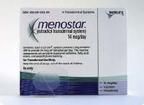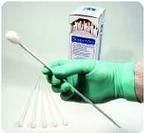New Products
NEW PRODUCTS
Listings are for information only and do not constitute endorsements.
FDA approves low-dose patch to prevent osteoporosis

Women with and without a uterus can now apply a new low-dose transdermal patch to prevent postmenopausal osteoporosis. Menostar is a clear, dime-sized once-a-week patch that delivers 14 µg/day of estradiol, an amount of plant-derived estrogen that's half the dose of the lowest currently available dose of transdermal estrogen therapy for this indication, according to Berlex, the US affiliate of Schering AG, Germany.
Results of a 2-year, randomized multicenter, placebo-controlled clinical trial of 417 postmenopausal women between ages 60 and 80 indicated that Menostar does not cause clinically significant endometrial hyperplasia. Therefore, the patch does not require a daily or monthly concomitant progestin to protect against endometrial cancer for women having an intact uterus. However, it is recommended that women on Menostar who have a uterus be treated with a progestin for 14 days every 6 to 12 months.
At the end of the study, Menostar increased lumbar spine bone mineral density (BMD) by 3% over baseline (P=<0.001) and 2.6% over placebo (P=<0.001). It raised hip BMD by 0.84% over baseline and 1.6% over placebo. For more information, visit the company Web site at http://www.berlex.com.
Consumer fertility magazine debuts
A lifestyle magazine for women billed as "America's first fertility magazine" is set to debut in September 2004. Targeting any woman planning to start (or add to) her family, Conceive magazine is owned and published by Intellectual Capital Productions, Inc. (Orlando, Fla.). It aims to provide patients with factual information on all aspects of reproduction, to save you and your staff office time. For information on free annual subscriptions for the waiting room or to hand out to patients, call 1-800-758-0770 or visit the magazine's Web site at http://www.conceivemagazine.com.
The lowdown on safe fish consumption and hormonal contraceptive drugs

Fish Consumption to Promote Good Health and Minimize Contaminants is one of two new Quick Reference Guides for clinicians from the Association of Reproductive Health Professionals (ARHP). This first bookletdeveloped jointly with Physicians for Social Responsibility (PSR)disputes the safe level of mercury recommended in the FDA/EPA's March 2004 Advisory, reviews toxic fish contaminants, and offers guidelines to promote better communication with patients on this topic.
The other new pamphlet from the ARHP, Administration of Hormonal Contraceptive Drugs, helps you quickly counsel women about all currently available hormonal contraceptive systems. Electronic copies of these and other publications are also available at http://www.arhp.org/guide. For additional copies of any ARHP publication, contact Rachel Fey at 202-466-3825 or at rfey@arhp.org.
Foot-long disposable applicators provide added reach

New foot-long Scopettes "Comfort Tip" applicators are the only 12-inch, large-tip applicators on the market, according to Birchwood Labs (Eden Prairie, Minn.). Designed for maximum patient comfort and safety during diagnostic and treatment procedures, these disposable applicators feature nonsized, highly absorbent rayon material heads on rigid, rolled paper sticks. They're soft, lint free, and may be sterilized by autoclave or ethylene oxide methods. The newly designed dispenser's tear-out panels permit half of the 100 applicators to initially remain packaged, lessening contamination.
For a free sample pack or more information, call 1-800-328-6156 or visit the Web site at http://www.birchlabs.com.
Software simplifies scheduling for multi-site practices
Ob/gyns with more than one practice site can simplify scheduling of appointments with AppointmentsCS (SpectraSoft, Inc., Tempe, Ariz.). Because the product links all practice sites to one centralized scheduling system, booking a patient at any location is just one mouse-click away. Based on the company's AppointmentsPRO software, the user-friendly interface lets staffers specify when each practitioner and resource is available at a given location, permitting schedulers at each site to book patients at any other location, with no need to make confirming phone calls or to manually re-enter appointments. Schedule changes are updated at each office in real time, keeping every user in sync.
The system, which requires only an Internet connection at each location, can streamline workflow, improve efficiency, and prevent unbillable visits, according to SpectraSoft, Inc. It can also run reports for individual locations or compile them for an entire organization. Other standard features and add-ons can verify insurance coverage or generate automated appointment reminders by phone, mail, and e-mail. For more information, visit http://www.spectrasoft.com or call John Wolf, marketing manager at 1-800-889-0450, ext. 301 (e-mail: jwolf@ssoft.com).
User-friendly guides answer pregnant patients' questions

The Your Pregnancy series of best-selling ob/gyn-authored guides announces the publication of three new additions that address a pregnant patient's special concerns: Your Pregnancy Quick Guide: Tests and Procedures; Your Pregnancy Quick Guide: Fitness and Exercise, and Your Pregnancy Quick Guide: Nutrition and Weight Management. The first of these paperbacks concisely covers what a woman should know about both routine and special check-ups, the second how to eat right and stay fit during pregnancy, and the third how to stay in shape throughoutalong with nutrition tips for breastfeeding mothers.
For more than 20 years the guides' authors, Glade Curtis, MD, and Judith Schuler, MS, have co-written books that include Your Pregnancy Week by Week and Your Pregnancy for the Father-to-Be. For more information, visit the publisher's Web site at http://www.dacapopress.com/preg.asp.
Helping patients overcome breastfeeding challenges
Because of the well-known health benefits of breastfeeding, the American College of Obstetricians and Gynecologists supports the US Public Health Service's Healthy People 2010 objective of having 75% of new mothers breastfeeding after delivery and having 50% still at it at 6 months. Moreover, the American Academy of Pediatrics recommends continuing breastfeeding for the first year of life. Unfortunately, many women give up far sooner.
That doesn't have to happen, says a new book, Moms, Babies , and Breastfeeding: What Resilient Mothers Know about Making Breastfeeding Work.
Analyzing common themes behind the stories of successful women who've overcome breastfeeding difficulties, it explains how ob/gyns can apply this to help breastfeeding patients become equally resilient. The author, Dr. Claudia Johnsen, PhD, is a pediatric nutritionist, a lactation consultant, and former senior nutritionist and breastfeeding coordinator for a Massachusetts Women, Infants, and Children Program. For more information, visit http://www.authorhouse.com.
New Products. Contemporary Ob/Gyn Aug. 1, 2004;49:98-102.
